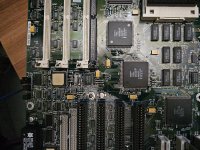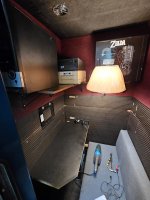Hi All! Been doing a fair amount of vintage computer stuff of late but by no means am I an expert (even if in the mid-90s I was building my own PC's). I was given a Gateway 2000 P5-60 tower. At first things were relatively good, except the Dallas battery/clock had a dead CMOS battery, no surprise. I got a new one and after a bit of adjusting got it booting up, set the date and time. I decided to get the cards out and clean them up as the thing was dusty as heck. I replaced the cards in the same slots, doing each card one at a time. Since then, I've not gotten it to boot to the bios screen.
Sometimes I get a single beep. I put a PCI diagnostic card in, and the boot freezes at a variety of places. I've done the usual work of cleaning out the slots to be sure nothing is bad there. the latest stopping point is at the 13 08 post code... and a noise I've never heard from a booting pc's little speaker, best described as a mid frequency buzz, almost a video-game style noise (if you have an apple II you might know what I mean). I've tried moving the cards around, swapping memory, the only thing I haven't tried swapping out yet is the power supply. I'm guessing the BIOS is in fact on the PC still, since I get these codes (via the 2nd PCI slot), right? if the flash was somehow vaped by me putting the wrong jumpers in the wrong place clearing the CMOS (argh) then I'd get no reaction at all, right?
It's quite frustrating to start the day with a working machine (save I couldn't set the date and BIOS settings), get the bios settings set, and then find that just pulling the cards out to clean them off kills the machine, thus ending the day with a dead machine... But hope springs eternal with your help I can figure this out. I appreciate any suggestions you have. I was thinking of getting the BIOS for the machine and reflashing it, just to be sure its good. Any help is appreciated. Let me know what information I can provide. Thanks!
Sometimes I get a single beep. I put a PCI diagnostic card in, and the boot freezes at a variety of places. I've done the usual work of cleaning out the slots to be sure nothing is bad there. the latest stopping point is at the 13 08 post code... and a noise I've never heard from a booting pc's little speaker, best described as a mid frequency buzz, almost a video-game style noise (if you have an apple II you might know what I mean). I've tried moving the cards around, swapping memory, the only thing I haven't tried swapping out yet is the power supply. I'm guessing the BIOS is in fact on the PC still, since I get these codes (via the 2nd PCI slot), right? if the flash was somehow vaped by me putting the wrong jumpers in the wrong place clearing the CMOS (argh) then I'd get no reaction at all, right?
It's quite frustrating to start the day with a working machine (save I couldn't set the date and BIOS settings), get the bios settings set, and then find that just pulling the cards out to clean them off kills the machine, thus ending the day with a dead machine... But hope springs eternal with your help I can figure this out. I appreciate any suggestions you have. I was thinking of getting the BIOS for the machine and reflashing it, just to be sure its good. Any help is appreciated. Let me know what information I can provide. Thanks!


